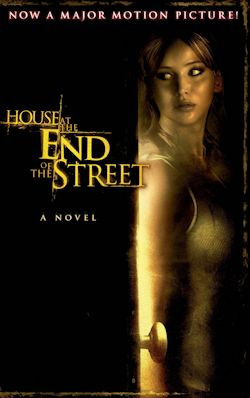Lily Blake’s novel, The House At The End Of The Street, originates from a screenplay penned by David Loucka, itself inspired by a story by Jonathan Mostow. This young adult horror thriller novelization offers a reading experience that leans heavily into suspense and creepiness, rather than extreme gore, making it a palatable choice for a younger audience or those who prefer milder horror.
Clocking in at just under 190 pages, The House At The End Of The Street is a relatively short read. Its pace is brisk, maintaining a level of suspense that keeps you engaged, even if it’s not profoundly original. The book’s core strength lies in its twist, which, while not entirely unique, is effectively delivered. The premise itself is intriguing enough to capture attention, though seasoned horror fans might find familiar tropes at play, which is common even in many horror movies. To delve too deeply into the plot would risk revealing key surprises, so it’s best to approach the story knowing as little as possible.
While the book is competently written, it doesn’t achieve a level of captivating prose. The narrative style clearly reflects its cinematic origins, feeling more like a scene-by-scene account of a movie rather than a deeply immersive literary experience. There’s a noticeable lack of descriptive depth, particularly in character development, which prevents a stronger emotional connection with the story. It reads somewhat like a direct transcription of the film, resulting in a slightly detached, wooden feel, even though the underlying movie concept might still translate into a watchable film.
 Book cover of The House at the End of the Street, a young adult horror thriller by Lily Blake featuring a dark house and prominent title text.
Book cover of The House at the End of the Street, a young adult horror thriller by Lily Blake featuring a dark house and prominent title text.
Despite not being a work of literary brilliance, The House At The End Of The Street succeeds within its genre as an entertaining piece. It quickly draws the reader in, prompting a desire to see the narrative unfold. While it may not induce edge-of-your-seat tension, it maintains a steady level of engagement throughout.
The story centers around Sarah and her daughter Elissa, whose relationship has become strained following Elissa’s father’s departure. Seeking a fresh start and hoping to guide Elissa away from perceived missteps, Sarah relocates them from the city to a quieter small town. They settle into an affordable rental home, its low price a consequence of a grim history: the previous house next door was the scene of a double murder committed by a teenage daughter. Adding to the unease, the son of the murdered couple, Ryan, still resides in the infamous house, much to the dismay of the townsfolk. Elissa’s chance encounter with Ryan one rainy evening, when he offers her a ride home, marks the beginning of an unlikely friendship. This budding relationship, against Sarah’s better judgment, inadvertently thrusts Ryan back into the community spotlight, a place he has deliberately avoided.
The House At The End Of The Street delivers on its promise of light suspense and entertainment. It evokes the feel of classic, low-budget horror movies, offering a nostalgic nod to the genre. For readers who appreciate thrillers with less graphic violence, reminiscent of movies like Scream or Nightmare on Elm Street but toned down, this book should appeal. It shares a similar vein with suspense films where the threat is more psychological and atmospheric. If you approach it with moderate expectations and an open mind, The House At The End Of The Street provides a satisfyingly suspenseful and quick read.

